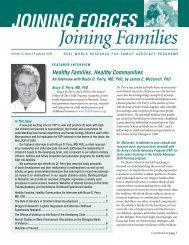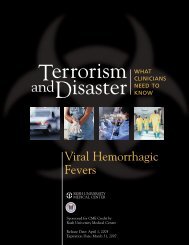stigma and barriers to care - Uniformed Services University of the ...
stigma and barriers to care - Uniformed Services University of the ...
stigma and barriers to care - Uniformed Services University of the ...
Create successful ePaper yourself
Turn your PDF publications into a flip-book with our unique Google optimized e-Paper software.
100<br />
Stigma <strong>and</strong> Barriers <strong>to</strong> Care — Caring for Those Exposed <strong>to</strong> War, Disaster <strong>and</strong> Terrorism<br />
address research first. Why Because, as Harry Holloway commented yesterday,<br />
research recommendations will require us <strong>to</strong> be more specific about what our<br />
operational variables are. We cannot talk about any <strong>of</strong> <strong>the</strong> o<strong>the</strong>rs unless we become<br />
a bit clearer on our operational variables. What are <strong>the</strong> operational variables that<br />
we need <strong>to</strong> learn more about What might need <strong>to</strong> be reorganized in our system;<br />
which are system comments <strong>to</strong> think about, address, consider What are training<br />
or education needs for providers, for leadership, for soldiers that might fur<strong>the</strong>r<br />
address <strong>the</strong>se issues What might we advise leadership <strong>to</strong> assist in <strong>the</strong>ir awareness,<br />
knowledge, <strong>and</strong> interventions in <strong>the</strong>se settings The spot that we might gravitate <strong>the</strong><br />
most <strong>to</strong>, but in truth, we know <strong>the</strong> least about, is <strong>to</strong> actually propose interventions,<br />
ei<strong>the</strong>r at <strong>the</strong> clinical patient level, or at <strong>the</strong> population level. That is <strong>the</strong> dicho<strong>to</strong>my<br />
<strong>to</strong> think through with <strong>the</strong> question <strong>of</strong> clinical <strong>and</strong> population interventions.<br />
With those introduc<strong>to</strong>ry comments, we are going <strong>to</strong> open <strong>the</strong> floor for discussion,<br />
<strong>and</strong> begin <strong>to</strong> capture some <strong>of</strong> our thoughts <strong>and</strong> recommendations.<br />
DR. ESTROFF: I have a question about <strong>the</strong> issue you just raised, <strong>the</strong> <strong>care</strong>er<br />
consequences <strong>of</strong> seeking help, which we have all identified as a barrier. Do you<br />
have any empirical data on <strong>care</strong>er trajec<strong>to</strong>ries <strong>of</strong> people who have sought <strong>care</strong> Not<br />
accounting for <strong>the</strong> fact that it is a preselected group, but it would seem <strong>to</strong> me <strong>to</strong> be<br />
really important <strong>to</strong> be able <strong>to</strong> address that in some way.<br />
DR. URSANO: First <strong>of</strong> all, I know studies have been done in <strong>the</strong> Air Force, in<br />
particular, <strong>to</strong> look at fliers who seek <strong>and</strong> receive psychiatric <strong>care</strong>, because <strong>the</strong>re is<br />
tremendous worry in that community around that <strong>to</strong>pic. The data say that 80% <strong>of</strong><br />
fliers go back <strong>to</strong> work, <strong>and</strong> complete <strong>the</strong>ir <strong>to</strong>ur. That means 20% do not. That may<br />
or not may not deal with <strong>the</strong> fear attached.<br />
Second, <strong>the</strong>re is great interest in this issue <strong>of</strong> <strong>care</strong>er trajec<strong>to</strong>ries. There has been<br />
some marvelous work on that many years ago by Card <strong>and</strong> o<strong>the</strong>rs. We need <strong>to</strong><br />
replicate that around <strong>the</strong> questions <strong>of</strong> health behaviors, <strong>and</strong> health risks, <strong>and</strong> <strong>the</strong>ir<br />
impacts on trajec<strong>to</strong>ry. Harry Holloway, you have been around long enough <strong>to</strong> know<br />
if <strong>the</strong>re are some o<strong>the</strong>r data specific <strong>to</strong> that.<br />
DR. HOLLOWAY: There are some. One is <strong>the</strong> SAMHSA study <strong>of</strong> fliers who enter<br />
in<strong>to</strong> alcoholic treatment, a study <strong>of</strong> matching <strong>the</strong>m <strong>care</strong>er-wise. Those who finished<br />
alcohol treatment <strong>the</strong>n had <strong>care</strong>ers that were better than <strong>the</strong>ir matched colleagues,<br />
<strong>the</strong>y move forward more rapidly, achieved more in terms <strong>of</strong> rank, etc. A set <strong>of</strong> operational<br />
items were examined. The Navy is very good about this in terms <strong>of</strong> instituting<br />
alcohol treatment, when alcohol went from being a crime, <strong>to</strong> being a treatment issue.<br />
They did a great deal <strong>of</strong> highlighting <strong>of</strong> flag rank <strong>of</strong>ficers who entered <strong>and</strong> successfully<br />
completed alcohol treatment at some stage during <strong>the</strong>ir <strong>care</strong>er.<br />
I think here it is very important <strong>to</strong> make sure that we speak generally. The paradox<br />
is that any injury or any disease must threaten your <strong>care</strong>er. There is frequently<br />
an issue <strong>of</strong> why confidentiality is so breached in this setting. Obviously one thing<br />
<strong>the</strong>y would like <strong>to</strong> improve is privacy. But <strong>the</strong> truth is, any time I get hepatitis, or<br />
any time I sprain my ankle, I threaten my <strong>care</strong>er. And if I seek <strong>care</strong>, I may solidify<br />
my capacity <strong>to</strong> continue my <strong>care</strong>er, or I may end my <strong>care</strong>er. These are <strong>the</strong> paradoxes<br />
<strong>of</strong> serving.<br />
DR. URSANO: Sue Estr<strong>of</strong>f, did you want <strong>to</strong> formulate something around that<br />
in<strong>to</strong> an area about which we need <strong>to</strong> learn more<br />
DR. ESTROFF: Yes. It is in <strong>the</strong> area <strong>of</strong> similarities <strong>and</strong> differences between <strong>the</strong><br />
civilian <strong>and</strong> <strong>the</strong> military population, which would be interesting <strong>to</strong> look at in terms<br />
<strong>of</strong> vocational consequences. Because <strong>the</strong>re, I think, we are going <strong>to</strong> see a huge differ-




